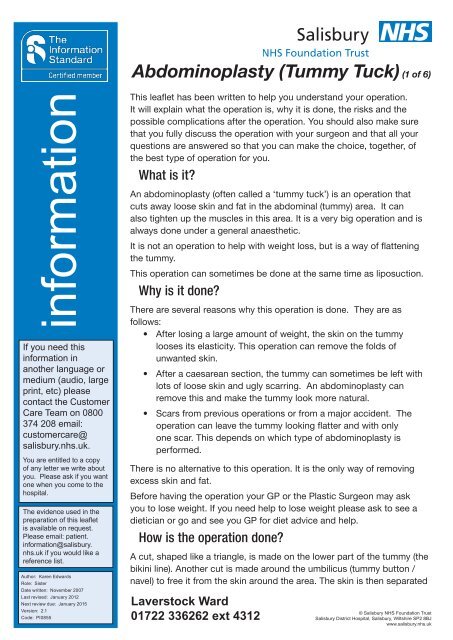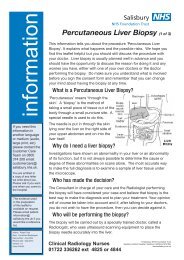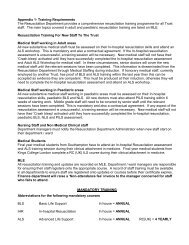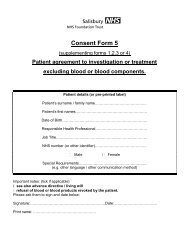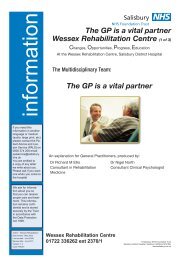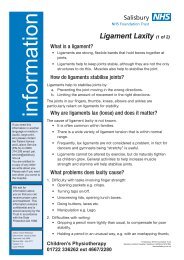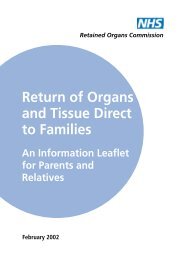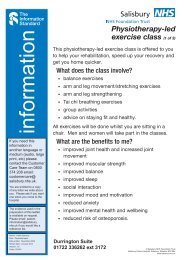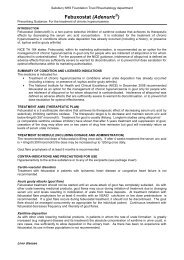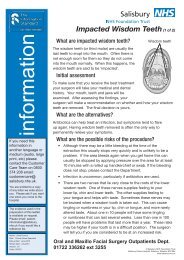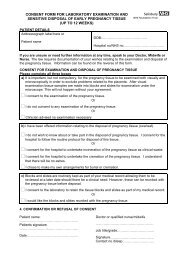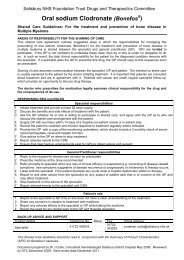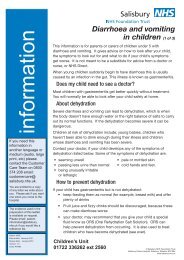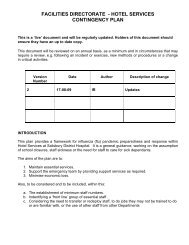Abdominoplasty (Tummy Tuck) - ICID - Salisbury NHS Foundation ...
Abdominoplasty (Tummy Tuck) - ICID - Salisbury NHS Foundation ...
Abdominoplasty (Tummy Tuck) - ICID - Salisbury NHS Foundation ...
Create successful ePaper yourself
Turn your PDF publications into a flip-book with our unique Google optimized e-Paper software.
information<br />
<strong>Abdominoplasty</strong> (<strong>Tummy</strong> <strong>Tuck</strong>) (1 of 6)<br />
If you need this<br />
information in<br />
another language or<br />
medium (audio, large<br />
print, etc) please<br />
contact the Customer<br />
Care Team on 0800<br />
374 208 email:<br />
customercare@<br />
salisbury.nhs.uk.<br />
You are entitled to a copy<br />
of any letter we write about<br />
you. Please ask if you want<br />
one when you come to the<br />
hospital.<br />
The evidence used in the<br />
preparation of this leaflet<br />
is available on request.<br />
Please email: patient.<br />
information@salisbury.<br />
nhs.uk if you would like a<br />
reference list.<br />
Author: Karen Edwards<br />
Role: Sister<br />
Date written: November 2007<br />
Last revised: January 2012<br />
Next review due: January 2015<br />
Version: 2.1<br />
Code: PI0855<br />
This leaflet has been written to help you understand your operation.<br />
It will explain what the operation is, why it is done, the risks and the<br />
possible complications after the operation. You should also make sure<br />
that you fully discuss the operation with your surgeon and that all your<br />
questions are answered so that you can make the choice, together, of<br />
the best type of operation for you.<br />
What is it?<br />
An abdominoplasty (often called a ‘tummy tuck’) is an operation that<br />
cuts away loose skin and fat in the abdominal (tummy) area. It can<br />
also tighten up the muscles in this area. It is a very big operation and is<br />
always done under a general anaesthetic.<br />
It is not an operation to help with weight loss, but is a way of flattening<br />
the tummy.<br />
This operation can sometimes be done at the same time as liposuction.<br />
Why is it done?<br />
There are several reasons why this operation is done. They are as<br />
follows:<br />
• After losing a large amount of weight, the skin on the tummy<br />
looses its elasticity. This operation can remove the folds of<br />
unwanted skin.<br />
• After a caesarean section, the tummy can sometimes be left with<br />
lots of loose skin and ugly scarring. An abdominoplasty can<br />
remove this and make the tummy look more natural.<br />
• Scars from previous operations or from a major accident. The<br />
operation can leave the tummy looking flatter and with only<br />
one scar. This depends on which type of abdominoplasty is<br />
performed.<br />
There is no alternative to this operation. It is the only way of removing<br />
excess skin and fat.<br />
Before having the operation your GP or the Plastic Surgeon may ask<br />
you to lose weight. If you need help to lose weight please ask to see a<br />
dietician or go and see you GP for diet advice and help.<br />
How is the operation done?<br />
A cut, shaped like a triangle, is made on the lower part of the tummy (the<br />
bikini line). Another cut is made around the umbilicus (tummy button /<br />
navel) to free it from the skin around the area. The skin is then separated<br />
Laverstock Ward<br />
01722 336262 ext 4312<br />
© <strong>Salisbury</strong> <strong>NHS</strong> <strong>Foundation</strong> Trust<br />
<strong>Salisbury</strong> District Hospital, <strong>Salisbury</strong>, Wiltshire SP2 8BJ<br />
www.salisbury.nhs.uk
<strong>Abdominoplasty</strong> (<strong>Tummy</strong> <strong>Tuck</strong>) (2 of 6)<br />
from the muscles underneath it. These muscles are sometimes pulled together to make them<br />
really tight and then stitched into place.<br />
The skin is pulled downward and all the extra skin is removed.<br />
The umbilicus is put back into a new position, so that it looks normal. The cuts are then stitched<br />
together. The operation takes about two hours to perform.<br />
What are the benefits and risks of this operation?<br />
The benefit of the operation is to have a tummy that looks flatter and to have tighter tummy<br />
muscles. Most people have some pain after the operation. This pain will start to get better when<br />
you start to get out of bed and walk around.<br />
Risks<br />
Scars: There will be scars from the operation. The number of scars will depend on which<br />
operation is performed. This will be discussed with you by your surgeon. Clothing, such as<br />
underwear, normally covers these. The pubic hairline might be higher than it was before. The<br />
scars will stretch from hip to hip. Sometimes they can become very ‘raised’ and look unsightly.<br />
They can also be red and itchy. This tends to reduce over the course of time.<br />
Umbilical and other changes: The umbilicus (tummy button) will look different after it has<br />
been stitched back into place. It will be a different shape from before the operation. You should<br />
discuss with your surgeon the type of tummy tuck you would like. There are several types of<br />
tummy tuck and each one will have a different effect on the tummy button.<br />
Loss of sensation: There may be numbness around the tummy scars and the outer side of<br />
the thighs. This is because small nerves which carry sensation from the skin are cut during the<br />
operation. This usually improves after about six months; however, sometimes the numbness will<br />
be permanent.<br />
Haematoma: Sometimes a collection of blood (haematoma) can form under the wound/skin.<br />
To help reduce the risk of this happening you will have a drain, which is a soft plastic tube,<br />
placed at each end of the wound. These drains will stay in place until the drainage stops. Despite<br />
the drains being in place this collection of blood can still occur. This is treated in different ways:<br />
• You may require a small operation to stop the bleeding or:<br />
• Nothing will be done, but it will be very carefully checked by the nurses or the doctors.<br />
Your body will reabsorb this blood over the course of a few weeks. The risk of this<br />
happening is less than 10%<br />
Seroma: This is a collection of fluid that builds up under the wound as a direct result of<br />
the operation. The drains should help to prevent this, but there is no guarantee that this will<br />
work. Either a nurse or a doctor using a needle and syringe can remove this fluid. It can be<br />
uncomfortable having this done. The risk of this happening is less than 5%.<br />
If you do develop a haematoma or a seroma it might be necessary to apply a thick dressing,<br />
called a pressure dressing, to try to prevent it from increasing in size.<br />
Excessive bleeding: This can mean having to have a blood transfusion and sometimes it can<br />
mean having to go back to theatre for another operation to stop the bleeding. The risk of this<br />
Laverstock Ward<br />
01722 336262 ext 4312<br />
© <strong>Salisbury</strong> <strong>NHS</strong> <strong>Foundation</strong> Trust<br />
<strong>Salisbury</strong> District Hospital, <strong>Salisbury</strong>, Wiltshire SP2 8BJ<br />
www.salisbury.nhs.uk
happening is less than 4%.<br />
<strong>Abdominoplasty</strong> (<strong>Tummy</strong> <strong>Tuck</strong>) (3 of 6)<br />
Infection and wound breakdown: Sometimes the wound may break down and not heal<br />
properly. This can be caused by infection and is usually treated successfully with antibiotics.<br />
However, in severe cases breakdown of the wound can mean having to have skin grafts.<br />
Deep Vein Thrombosis (Venous Thromboembolism – VTE): This is caused by a blood clot<br />
forming in the leg veins. To help to prevent this patients are encouraged to be up and about<br />
as soon as possible. After your operation you may have cuffs on your legs like blood pressure<br />
cuffs; these massage your calfs and help prevent clots. VTE is a very serious complication and<br />
if a clot ‘breaks away’ it can get into the lungs and cause a Pulmonary Embolism which can be<br />
fatal. To help prevent this from happening you may be given a daily injection called Dalteparin.<br />
This injection makes your blood take slightly longer than normal to clot which reduces the risk of<br />
a blood clot forming.<br />
Coming into hospital<br />
You will come into hospital on the day of your operation. You will be admitted to the Surgical<br />
Admissions Lounge.<br />
You will need to bring in with you:<br />
• Nightwear<br />
• Dressing gown<br />
• Slippers<br />
• Toiletries<br />
• Small amount of money for the phone/TV and newspapers<br />
• Fruit squash<br />
• Books / magazines<br />
Please do not bring in large amounts of money or jewellery.<br />
Before your operation<br />
Before coming into hospital, you may be sent an appointment for the Preadmission Clinic (PAC).<br />
In the clinic, a nurse will examine you to make sure you are fit for a general anaesthetic. You will<br />
also have the following:<br />
• Blood tests<br />
• Swabs taken from your nose and groin to make sure you do not have MRSA (Methicillin<br />
Resistant Staphylococcus Aureus)<br />
• Photo taken of your tummy.<br />
You may also need:<br />
• Chest x-ray<br />
• ECG (heart tracing).<br />
The nurse will explain the operation to you and will answer any questions you may have. (It is a<br />
good idea to write them down before you come in to the clinic).<br />
Laverstock Ward<br />
01722 336262 ext 4312<br />
© <strong>Salisbury</strong> <strong>NHS</strong> <strong>Foundation</strong> Trust<br />
<strong>Salisbury</strong> District Hospital, <strong>Salisbury</strong>, Wiltshire SP2 8BJ<br />
www.salisbury.nhs.uk
<strong>Abdominoplasty</strong> (<strong>Tummy</strong> <strong>Tuck</strong>) (4 of 6)<br />
If you are not seen in the PAC, all of this will be done when you come into hospital for your<br />
operation.<br />
You will be asked to sign a consent form. This form means that you are agreeing to the operation<br />
and have been told about all the risks and benefits. Read it carefully before you sign it. You will<br />
be given a copy of it for your own personal record. Remember you are free to change your mind<br />
about having the operation at any time.<br />
Eating and drinking<br />
You will be asked to have nothing to eat for at least 5 hours before you go to theatre for your<br />
operation and nothing to drink for 3 hours before it – this last drink, should be milk free.<br />
Going to theatre<br />
Before going to theatre you will be asked to take off all your clothes and to put on a theatre<br />
gown, this does up at the back.<br />
Any jewellery that cannot be removed will be taped to prevent it falling off during the operation,<br />
General anaesthetic<br />
A general anaesthetic means you are very deeply asleep. You will not be aware of anything.<br />
When you wake up, you will be in the Recovery area. You will stay here until you are awake<br />
enough to return to the ward. There may be a mask over your face. This is to give you oxygen to<br />
help you wake up.<br />
You will also have a drip in your arm; this is kept in place until you are feeling well enough to eat<br />
and drink as normal.<br />
What else?<br />
There are several other things you need to know. They are:<br />
Drains These are very soft plastic tubes that are placed into the wound. A special bag is<br />
attached at the end of them to collect any fluid that is draining from the wound. There will be two<br />
of these and they will be removed when the drainage is at a level that the doctors are happy with.<br />
Support garment This is a special garment that goes around your tummy. It helps with<br />
support and keeps you comfortable. You will need to buy a medium support panty girdle to<br />
support your tummy as it heals. You will need to wear this every day for six weeks.<br />
Wound dressing There will be a dressing over the wound underneath the support garment.<br />
Constipation It is very important that you don’t become constipated. If you do, it will make<br />
you feel very uncomfortable and could cause strain on your tummy muscles. You need to drink<br />
plenty of water and other drinks throughout the day (about 2 litres) and eat a high fibre diet. If you<br />
would like more information about a high fibre diet please ask the nursing staff.<br />
Back on the ward<br />
On your return to the ward, the nursing staff will:<br />
• Frequently check your blood pressure and pulse. This is done to make sure that any early<br />
Laverstock Ward<br />
01722 336262 ext 4312<br />
© <strong>Salisbury</strong> <strong>NHS</strong> <strong>Foundation</strong> Trust<br />
<strong>Salisbury</strong> District Hospital, <strong>Salisbury</strong>, Wiltshire SP2 8BJ<br />
www.salisbury.nhs.uk
<strong>Abdominoplasty</strong> (<strong>Tummy</strong> <strong>Tuck</strong>) (5 of 6)<br />
signs of bleeding or infection are dealt with as quickly as possible.<br />
• Make sure your drip is running to time and that you are being kept hydrated.<br />
• Check the wound areas to make sure there is not excessive bleeding and monitor the<br />
amount of drainage from the drains.<br />
• Make sure your pain is controlled. It will be controlled by different methods. If you are not<br />
comfortable and the pain is not being controlled, please tell the nursing staff.<br />
• Some people will be given extra oxygen to breath. The nurses will monitor the oxygen<br />
which may continue for a few hours or overnight.<br />
• Let you start drinking and eating when you feel well enough.<br />
Day 1<br />
• The nursing staff will help you wash in bed but if you feel up to it, you may sit out by your<br />
bed to do this. You may feel up to walking out to the bathroom.<br />
• The doctors will see you.<br />
• You will have a blood test to make sure there has not been too much blood loss during the<br />
operation. If there has, you may require a blood transfusion.<br />
• If you are eating and drinking the drip will be taken down.<br />
• Your blood pressure and pulse will be regularly checked.<br />
• If you were prescribed oxygen this will probably be stopped.<br />
• Medication will be given to control your pain.<br />
• If you feel up to it, you will be helped out of bed and sit in your chair for a while. Getting<br />
out of bed and moving around helps prevent chest infections and blood clots.<br />
Day 2<br />
• You will be able to wash yourself with less help from the nursing staff.<br />
• The doctors will see you.<br />
• You will be encouraged to become more mobile and walk around the ward<br />
• Medication will be given to control your pain.<br />
When you get out of bed you will not be able, or allowed, to stand up straight. You will be<br />
encouraged to be slightly bent forward – a bit like a banana shape!<br />
• Your blood pressure and pulse will be regularly checked.<br />
The dressing on your wound will be left in place. This will only be changed if it is soiled, or when<br />
the drains come out. It will also be checked before you go home.<br />
Going home (discharge advice)<br />
Once your drains have been removed and the doctors are satisfied with your progress you will be<br />
discharged home.<br />
Appointments You will be seen in a <strong>Salisbury</strong> District Hospital Plastic Outpatients Dressing<br />
Clinic. The appointment will be with a nurse at approximately one week after discharge. If<br />
Laverstock Ward<br />
01722 336262 ext 4312<br />
© <strong>Salisbury</strong> <strong>NHS</strong> <strong>Foundation</strong> Trust<br />
<strong>Salisbury</strong> District Hospital, <strong>Salisbury</strong>, Wiltshire SP2 8BJ<br />
www.salisbury.nhs.uk
<strong>Abdominoplasty</strong> (<strong>Tummy</strong> <strong>Tuck</strong>) (6 of 6)<br />
you live a long distance from <strong>Salisbury</strong> your first appointment will still need to be in <strong>Salisbury</strong>.<br />
Appointments after your first one may be able to be nearer your home. The only exception to<br />
this is patients from the Isle of Wight, where patients either go to the Consultant Clinic or the<br />
Outpatients Department at St Mary’s Hospital.<br />
Dressings Your dressings need to be kept dry until your Dressing Clinic appointment. Visits<br />
from the District Nurse will be arranged if your wound requires dressing before your first<br />
appointment. We will arrange the first visit of the District Nurse and give you a letter for the nurse<br />
and enough dressings for three days.<br />
Doctors letter The doctors will write a summary of your stay in hospital for your GP. You will<br />
be given a copy of this. You will also be given details of any medications you are taking home.<br />
One of the ward nurses will do all this for you.<br />
Fitness to Work (previously known as a Medical Certificate) If you need one, please ask<br />
before you leave hospital.<br />
Lifting When you go home it is important that there is someone to look after you for a while to<br />
do any heavy domestic chores. Do not lift young children until your tummy is no longer tender -<br />
usually 4 - 6 weeks.<br />
Driving We recommend that you wait until you feel well and comfortable enough before you<br />
start to drive again. This could take up to four weeks. You are not exempt from wearing a seat<br />
belt whilst in the car. It is advisable to talk to your insurance company before you start to drive<br />
again.<br />
Going back to work You will need to take at least six weeks off work. You will find that you tire<br />
easily for up to a month after the operation. When you should go back to work depends on the<br />
type of work that you do, your general recovery following your operation and what you agree with<br />
your GP.<br />
Sexual activity This can resume once the scars have healed. Remember though that your<br />
tummy will be tender for several weeks.<br />
Swimming / Sunbathing There is nothing to stop you swimming and sunbathing once the<br />
scars have healed.<br />
Questions?<br />
If you have any worries or questions, please contact:<br />
Laverstock ward 01722 336262 ext 4312 evenings and weekends.<br />
Plastic Outpatients 01722 345550 Monday to Friday during the day<br />
We wish you a speedy recovery and thank you for taking the time to read this information.<br />
Laverstock Ward<br />
01722 336262 ext 4312<br />
© <strong>Salisbury</strong> <strong>NHS</strong> <strong>Foundation</strong> Trust<br />
<strong>Salisbury</strong> District Hospital, <strong>Salisbury</strong>, Wiltshire SP2 8BJ<br />
www.salisbury.nhs.uk


